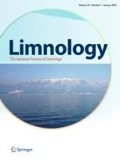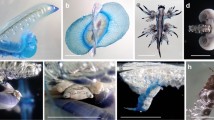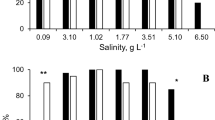Abstract
Daphnia magna is a cladoceran used as a model organism in aquatic ecology and ecotoxicology studies. Because growth is a critical parameter to study the effect of environmental conditions on the development of zooplankters, the somatic growth of D. magna was measured here and described by the von Bertalanffy growth equation (VBGE), a mathematical model widely used in fisheries management. For this purpose, the effect of two temperatures (20 and 25°C) and two photoperiod conditions (12:12 and 16:8, light:dark) was assayed. Experiments began with neonate females and were finished when parthenogenetic females reached the age of 41 days; they were fed the microalga Ankistrodesmus falcatus (400,000 cell ml−1, 12 mg l−1, dry weight). According to the VBGE, maximal length (L max) was inversely correlated with the growth rate (K). The highest L max (6.45 mm) was for the females grown at 20°C with the 12:12 photoperiod, whereas the maximum growth rate (K = 0.182 ± 0.010) was for individuals grown at 25°C with the 12:12 photoperiod. The number of clutches during the studied period was significantly higher for females grown at 25°C, 12:12. Temperature affected the growth rate and the maximum size in D. magna; interaction of temperature with photoperiod was also noteworthy. The VBGE was a nifty way to assess the effects of the tested environmental factors.


Similar content being viewed by others
References
Alekseev V, Lajus DL (2009) Maternal and direct effects of natural-like changes of photoperiod and food condition manipulation on life history parameters in Daphnia. Aquat Ecol 43:415–421
Alekseev V, Lampert W (2004) Maternal effects of photoperiod and food level on life history characteristics of the cladoceran Daphnia pulicaria Forbes. Hydrobiologia 526:225–230
Angilleta MJ Jr, Steury TD, Sears MW (2004) Temperature, growth rate, and body size in ectotherms: fitting pieces of a life-history puzzle. Integr Comp Biol 44:498–509
Asaeda T, Acharya K (2000) Application of individual growth and population models of Daphnia pulex to Daphnia magna, Daphnia galeata and Bosmina longirostris. Hydrobiologia 421:141–155
Baltanás A, Otero M, Arqueros L, Rossetti G, Rossi VV (2000) Onthogenic changes in the carapace shape of the non-marine ostracod Eucypris virens (Jurine). Hydrobiologia 419:65–72
Beverton RJH, Holt SJ (1957) On the dynamics of exploited fish populations. Fish Invest Lond 19:1–533
Caddy JF (2003) Scaling elapsed time: an alternative approach to modelling crustacean moulting schedules? Fish Res 63:73–84
Company JB, Sardà F (2000) Growth parameters of deep-water decapod crustaceans in the Northwestern Mediterranean Sea: a comparative approach. Mar Biol 136:79–90
Elendt BP (1990) Selenium deficiency in Crustacea. An ultrastructural approach to antennal damage in Daphnia magna Straus. Protoplasma 154:25–33
Fontoura NF, Agostinho AA (1996) Growth with seasonally varying temperatures: an expansion of the von Bertalanffy growth model. J Fish Biol 48:569–584
Gamit S (1998) Growth models and their use in ecological modelling: an application to a fish population. Ecol Model 113:83–94
Güntzel AM, Matsumara-Tundisi T, Rocha O (2003) Life cycle of Macrothrix flabelligera Smirnov, 1992 (Cladocera, Macrothricidae), recently reported in the Neotropical region. Hydrobiologia 490:87–92
Karkach AS (2006) Trajectories and models of individual growth. Demogr Res 15:347–400. (Available at: http://www.demographic-research.org/Volumes/Vol15/12/, cited 30 Jun 2010)
Kirk KL (1992) Effects of suspended clay on Daphnia body growth and fitness. Freshw Biol 28:103–109
Lampert, W (1987) Feeding and nutrition in Daphnia. In: Peters RH, de Bernardi R (eds) Daphnia. Mem Ist Ital Idrobiol 45:143–192
Li H, Liu Q, Shen Z (1997) Investigation of an iterative method for fitting von Bertalanffy growth equation using data on the halfbeak fish Hemirhamphus sajori (T et S). Fish Res 29:289–294
Martínez-Jerónimo F, Villaseñor R, Ríos G, Espinosa F (1994) Effect of food type and concentration on the survival, longevity, and reproduction of Daphnia magna. Hydrobiologia 287:207–214
McCauley E, Murdoch WW, Nisbet RM (1990) The physiological ecology of Daphnia: development of a model of growth and reproduction. Ecology 71:703–715
Mooij WM, Hülsmann S, Vijverberg J, Veen A, Lammens EHRR (2003) Modeling Daphnia population dynamics and demography under natural conditions. Hydrobiologia 491:19–34
Partridge L, French V (1996) Thermal evolution of ectotherm body size: why get big in the cold? In: Johnston IA, Bennett AF (eds) Animals and temperature: phenotypic and evolutionary adaptation. Cambridge University Press, Cambridge, pp 265–292
Phillips BF, Campbell NA, Rea WA (1977) Laboratory growth of early juveniles of the western rock lobster Panulirus longipes cygnus. Mar Biol 39:31–39
Rafail SZ (1973) A simple and precise method for fitting a von Bertalanffy growth curve. Mar Biol 19:354–358
Santojanni A, Gorbi G, Sartore F (1998) Prediction of fecundity in chronic toxicity tests on Daphnia magna. Water Res 32:3146–3156
Siegfried KI, Sansó B (2006) Two Bayesian methods for estimating parameters of the von Bertalanffy growth equation. Environ Biol Fish 77:301–308
Simpson EP, Hurlbert SH (1998) Salinity effects on the growth, mortality and shell strength of Balanus amphitrite from the Salton Sea, California. Hydrobiologia 381:179–190
Sokal RR, Rohlf FJ (1981) Biometry, 2nd edn. W. H. Freeman and Co, San Francisco
Starkweather PL (1983) Daily patterns of feeding behaviour in Daphnia and related microcrustacea: implications for cladocera autoecology and the zooplankton community. Hydrobiologia 100:203–221
Teissier G (1960) Relative growth. In: Waterman TH (ed) The physiology of Crustacea, vol I. Metabolism and growth. Academic Press, New York, pp 537–560
Tessier AJ, Goulden CE (1987) Cladoceran juvenile growth. Limnol Oceanogr 32:680–686
Threlkeld ST (1987) Daphnia life history strategies and resource allocation patterns. In: Peters RH, de Bernardi R (eds) Daphnia. Mem Ist Ital Idrobiol 45:353–366
US Environmental Protection Agency (2002) Methods for measuring the acute toxicity of effluents and receiving waters to freshwater and marine organisms, 5th edn. EPA-821-R-02-012 Ohio
Weber CI (1993) Methods for measuring the acute toxicity of effluents and receiving waters to freshwater and marine organisms, 4th edn. United States Environmental Protection Agency, Cincinnati, EPA/600/4-90/027F
Acknowledgments
Thanks to the Sistema de Estímulo al Desempeño de los Investigadores (EDI) and the Comisión de Operación y Fomento de Actividades Académicas (COFAA) of the I.P.N. for the support given. Also thanks to Ms. Ingrid Mascher for editorial assistance and review of the English manuscript. Laura Martínez-Jerónimo helped in the laboratory procedures. Finally, I thank the two anonymous reviewers whose comments and critical evaluation helped to improve this manuscript.
Author information
Authors and Affiliations
Corresponding author
Rights and permissions
About this article
Cite this article
Martínez-Jerónimo, F. Description of the individual growth of Daphnia magna (Crustacea: Cladocera) through the von Bertalanffy growth equation. Effect of photoperiod and temperature. Limnology 13, 65–71 (2012). https://doi.org/10.1007/s10201-011-0356-2
Received:
Accepted:
Published:
Issue Date:
DOI: https://doi.org/10.1007/s10201-011-0356-2




